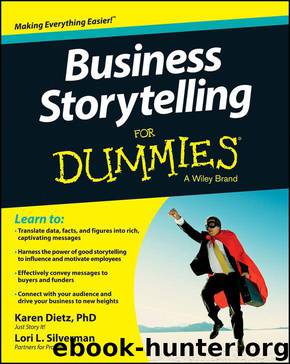Business Storytelling For Dummies (For Dummies (Business & Personal Finance)) by Karen Dietz & Lori L. Silverman

Author:Karen Dietz & Lori L. Silverman [Dietz, Karen]
Language: eng
Format: mobi
Publisher: Wiley
Published: 2013-11-21T14:00:00+00:00
Know when to speed up and slow down
Rhythm in storytelling occurs through pacing and pausing (for example, fast–pause–slow–pause–fast) and repetition (“around and around they went . . .”). Pacing — slowing down and speeding up as you tell different sections of a story — is a way to build variety into your delivery. It can also wake people up and keep them involved and engaged in your story.
Hail to the power of the pause! Often we’re so excited to tell a story that we forget to breathe. Pausing is powerful: It’s a way to wake people up and build their anticipation for what’s coming next. It builds drama and tension.
Pausing during select moments while telling a story also allows people to keep up with you and process what you’re saying. As you speak, they’re feasting on your images — digesting them and making them their own. Sometimes there’s a lag between an image you deliver and the mind of the listener who’s internalizing it. Make time for this.
Let’s try these skills. Without any pausing, pacing, or repetition, speak the next paragraph out loud. It’s from the story we lengthened in Chapter 9:
For a while, the county had been working with a coalition of community groups and city staff to implement a 50-mile bike path through the city and the back country. The project would increase parkland along the corridor, commuting to work by bike, and the safety of the roadways. Everyone agreed on the value of the project.
Now, add in pauses, pacing, and repetition and hear the difference:
For a while, (pause) the county had been working with a coalition of community groups and city staff (pause) to implement a 50-mile bike path through the city and the back country. (pick up the pace) The project would increase parkland along the corridor commuting to work by bike, and the safety of the roadways. (slow down now) Everyone, everyone (repetition) agreed on the value of the project.
Build pauses, pacing, and repetition into your story judiciously. You’ll know you have a good balance of rhythm and repetition when a story captivates listeners — you’ll feel people physically move with you as you share the story, and they’ll describe the story as being in sync with their experience.
Download
This site does not store any files on its server. We only index and link to content provided by other sites. Please contact the content providers to delete copyright contents if any and email us, we'll remove relevant links or contents immediately.
Nudge - Improving Decisions about Health, Wealth, and Happiness by Thaler Sunstein(7617)
Deep Work by Cal Newport(6880)
Principles: Life and Work by Ray Dalio(6217)
Factfulness: Ten Reasons We're Wrong About the World – and Why Things Are Better Than You Think by Hans Rosling(4694)
The Doodle Revolution by Sunni Brown(4689)
Eat That Frog! by Brian Tracy(4436)
Thinking in Bets by Annie Duke(4153)
Hyperfocus by Chris Bailey(4052)
Visual Intelligence by Amy E. Herman(3724)
Writing Your Dissertation in Fifteen Minutes a Day by Joan Bolker(3670)
Ogilvy on Advertising by David Ogilvy(3511)
How to Win Friends and Influence People in the Digital Age by Dale Carnegie & Associates(3497)
Hidden Persuasion: 33 psychological influence techniques in advertising by Marc Andrews & Matthijs van Leeuwen & Rick van Baaren(3473)
How to win friends and influence people by Dale Carnegie(3399)
The Pixar Touch by David A. Price(3364)
Schaum's Quick Guide to Writing Great Short Stories by Margaret Lucke(3319)
Deep Work: Rules for Focused Success in a Distracted World by Cal Newport(3146)
Work Clean by Dan Charnas(3051)
The Slow Fix: Solve Problems, Work Smarter, and Live Better In a World Addicted to Speed by Carl Honore(2947)
